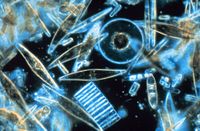
Photo from wikipedia
This study describes two viral communities from the world’s oldest lake, Lake Baikal. For the analysis, we chose under-ice and late spring periods of the year as the most productive… Click to show full abstract
This study describes two viral communities from the world’s oldest lake, Lake Baikal. For the analysis, we chose under-ice and late spring periods of the year as the most productive for Lake Baikal. These periods show the maximum seasonal biomass of phytoplankton and bacterioplankton, which are targets for viruses, including bacteriophages. At that time, the main group of viruses were tailed bacteriophages of the order Caudovirales that belong to the families Myoviridae, Siphoviridae and Podoviridae. Annotation of functional genes revealed that during the under-ice period, the “Phages, Prophages, Transposable Elements and Plasmids” (27.4%) category represented the bulk of the virome. In the late spring period, it comprised 9.6% of the virome. We assembled contigs by two methods: Separately assembled in each virome or cross-assembled. A comparative analysis of the Baikal viromes with other aquatic environments indicated a distribution pattern by soil, marine and freshwater groups. Viromes of lakes Baikal, Michigan, Erie and Ontario form the joint World’s Largest Lakes clade.
Journal Title: Viruses
Year Published: 2019
Link to full text (if available)
Share on Social Media: Sign Up to like & get
recommendations!